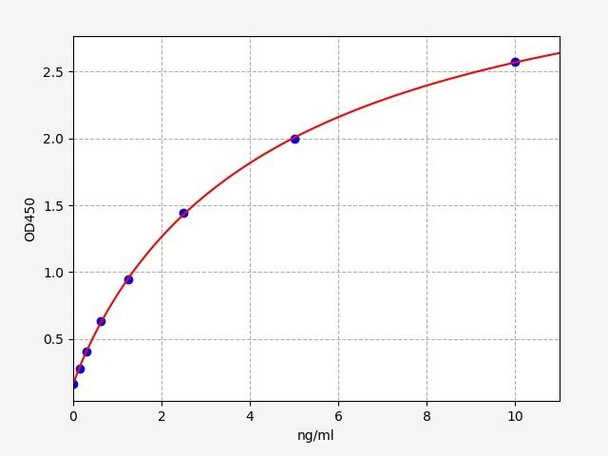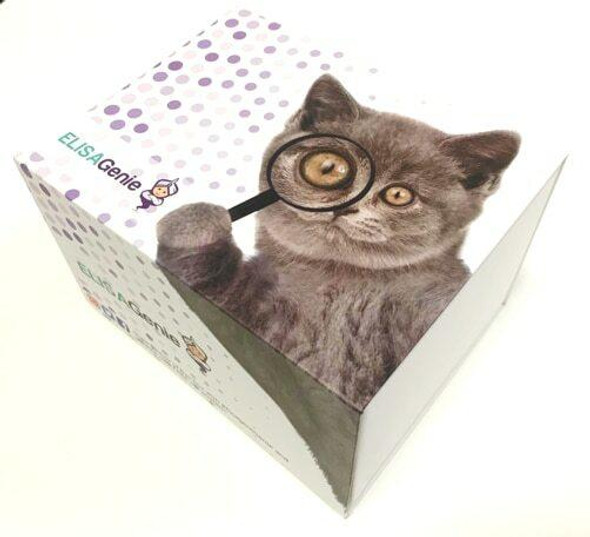Human DLD / Dihydrolipoyl Dehydrogenase ELISA Kit (HUFI02393)
- SKU:
- HUFI02393
- Product Type:
- ELISA Kit
- Size:
- 96 Assays
- Uniprot:
- P09622
- Sensitivity:
- 0.094ng/ml
- Range:
- 0.156-10ng/ml
- ELISA Type:
- Sandwich
- Synonyms:
- DLD, Diaphorase, DLD, DLDD, DLDH, GCSL, LAD, Lipoamide Dehydrogenase, PHE3, 2-oxo-glutaRate complex, branched chain keto acid dehydrogenase complex, branched chain keto acid dehydrogenase complex, dihydrolipoamide dehydrogenase, E3 component of pyruv
- Reactivity:
- Human
- Research Area:
- Cell Biology
Description
Human DLD/Dihydrolipoyl Dehydrogenase ELISA Kit
The Human DLD (Dihydrolipoyl Dehydrogenase) ELISA Kit is specifically designed for the accurate measurement of DLD levels in human serum, plasma, and cell culture supernatants. This kit boasts high sensitivity and specificity, ensuring dependable and consistent results that are perfect for a variety of research purposes.DLD is a key enzyme involved in energy production within the mitochondria and is essential for normal cell function.
Dysregulation of DLD has been linked to various metabolic disorders, making it a valuable biomarker for studying these conditions and potentially developing new treatments.With the Human DLD ELISA Kit, researchers can confidently measure DLD levels in human samples with precision and accuracy, providing valuable insights into cellular metabolism and disease mechanisms.
| Product Name: | Human DLD / Dihydrolipoyl Dehydrogenase ELISA Kit |
| Product Code: | HUFI02393 |
| Size: | 96 Assays |
| Alias: | DLD, Diaphorase, DLD, DLDD, DLDH, GCSL, LAD, Lipoamide Dehydrogenase, PHE3, 2-oxo-glutaRate complex, branched chain keto acid dehydrogenase complex |
| Detection method: | Sandwich ELISA, Double Antibody |
| Application: | This immunoassay kit allows for the in vitro quantitative determination of Human DLD concentrations in serum plasma and other biological fluids. |
| Sensitivity: | 0.094ng/ml |
| Range: | 0.156-10ng/ml |
| Storage: | 4°C for 6 months |
| Note: | For Research Use Only |
| Recovery: | Matrices listed below were spiked with certain level of Human DLD and the recovery rates were calculated by comparing the measured value to the expected amount of Human DLD in samples. | ||||||||||||||||
| |||||||||||||||||
| Linearity: | The linearity of the kit was assayed by testing samples spiked with appropriate concentration of Human DLD and their serial dilutions. The results were demonstrated by the percentage of calculated concentration to the expected. | ||||||||||||||||
| |||||||||||||||||
| CV(%): | Intra-Assay: CV<8% Inter-Assay: CV<10% |
| Component | Quantity | Storage |
| ELISA Microplate (Dismountable) | 8×12 strips | 4°C for 6 months |
| Lyophilized Standard | 2 | 4°C/-20°C |
| Sample/Standard Dilution Buffer | 20ml | 4°C |
| Biotin-labeled Antibody(Concentrated) | 120ul | 4°C (Protect from light) |
| Antibody Dilution Buffer | 10ml | 4°C |
| HRP-Streptavidin Conjugate(SABC) | 120ul | 4°C (Protect from light) |
| SABC Dilution Buffer | 10ml | 4°C |
| TMB Substrate | 10ml | 4°C (Protect from light) |
| Stop Solution | 10ml | 4°C |
| Wash Buffer(25X) | 30ml | 4°C |
| Plate Sealer | 5 | - |
Other materials and equipment required:
- Microplate reader with 450 nm wavelength filter
- Multichannel Pipette, Pipette, microcentrifuge tubes and disposable pipette tips
- Incubator
- Deionized or distilled water
- Absorbent paper
- Buffer resevoir
| Uniprot | P09622 |
| UniProt Protein Function: | DLD: a multi-functional mitochondrial enzyme. An enzymatic component of the mitochondrial glycine cleavage system, the pyruvate dehydrogenase complex (PDHC), the alpha-ketoglutarate dehydrogenase complex, and the branched-chain alpha-keto acide dehydrogenase complex. Is the E3 component of the PDHC that catalyzes the overall conversion of pyruvate to acetyl-CoA and CO2. The E3 component has dihydrolipoamide dehydrogenase activity. The PDHC contains 20-30 copies of pyruvate decarboxylase tetramers (2 alpha:2 beta)(E1), 60 copies of dihydrolipoamide acetyltransferase (E2), six homodimers of dihydrolipoamide dehydrogenase (E3), plus E3 binding proteins. Defects in DLD are a cause of maple syrup urine disease (MSUD), characterized by mental and physical retardation, feeding problems and a maple syrup odor to the urine. The keto acids of the branched-chain amino acids are present in the urine, resulting from a block in oxidative decarboxylation. Differentially expressed in the Wernicke's Area from patients with schizophrenia. Inhibited by 5-methoxyindole-2-carboxylic acid (MICA). |
| UniProt Protein Details: | Protein type:Amino Acid Metabolism - glycine, serine and threonine; Amino Acid Metabolism - valine, leucine and isoleucine degradation; Oxidoreductase; Carbohydrate Metabolism - glycolysis and gluconeogenesis; Mitochondrial; EC 1.8.1.4; Carbohydrate Metabolism - pyruvate; Carbohydrate Metabolism - citrate (TCA) cycle Chromosomal Location of Human Ortholog: 7q31-q32 Cellular Component: nucleoplasm; mitochondrion; mitochondrial matrix; acrosomal matrix; cilium Molecular Function:mercury (II) reductase activity; FAD binding; mercury ion binding; dihydrolipoyl dehydrogenase activity; NADP binding Biological Process: cellular metabolic process; regulation of membrane potential; mitochondrial electron transport, NADH to ubiquinone; cell redox homeostasis; tricarboxylic acid cycle; detoxification of mercury ion; lysine catabolic process; regulation of acetyl-CoA biosynthetic process from pyruvate; gastrulation; branched chain family amino acid catabolic process; proteolysis; pyruvate metabolic process; sperm capacitation Disease: Dihydrolipoamide Dehydrogenase Deficiency |
| NCBI Summary: | This gene encodes a member of the class-I pyridine nucleotide-disulfide oxidoreductase family. The encoded protein has been identified as a moonlighting protein based on its ability to perform mechanistically distinct functions. In homodimeric form, the encoded protein functions as a dehydrogenase and is found in several multi-enzyme complexes that regulate energy metabolism. However, as a monomer, this protein can function as a protease. Mutations in this gene have been identified in patients with E3-deficient maple syrup urine disease and lipoamide dehydrogenase deficiency. Alternative splicing results in multiple transcript variants. [provided by RefSeq, Jan 2014] |
| UniProt Code: | P09622 |
| NCBI GenInfo Identifier: | 269849557 |
| NCBI Gene ID: | 1738 |
| NCBI Accession: | P09622.2 |
| UniProt Secondary Accession: | P09622,Q14131, Q14167, Q59EV8, Q8WTS4, B2R5X0, B4DHG0 B4DT69, |
| UniProt Related Accession: | P09622 |
| Molecular Weight: | 509 |
| NCBI Full Name: | Dihydrolipoyl dehydrogenase, mitochondrial |
| NCBI Synonym Full Names: | dihydrolipoamide dehydrogenase |
| NCBI Official Symbol: | DLD |
| NCBI Official Synonym Symbols: | E3; LAD; DLDD; DLDH; GCSL; PHE3 |
| NCBI Protein Information: | dihydrolipoyl dehydrogenase, mitochondrial; diaphorase; lipoamide reductase; lipoamide dehydrogenase; glycine cleavage system L protein; glycine cleavage system protein L; E3 component of pyruvate dehydrogenase complex, 2-oxo-glutarate complex, branched chain keto acid dehydrogenase complex |
| UniProt Protein Name: | Dihydrolipoyl dehydrogenase, mitochondrial |
| UniProt Synonym Protein Names: | Dihydrolipoamide dehydrogenase; Glycine cleavage system L protein |
| Protein Family: | Delta-like protein |
| UniProt Gene Name: | DLD |
| UniProt Entry Name: | DLDH_HUMAN |
*Note: Protocols are specific to each batch/lot. For the correct instructions please follow the protocol included in your kit.
Before adding to wells, equilibrate the SABC working solution and TMB substrate for at least 30 min at 37°C. When diluting samples and reagents, they must be mixed completely and evenly. It is recommended to plot a standard curve for each test.
| Step | Protocol |
| 1. | Set standard, test sample and control (zero) wells on the pre-coated plate respectively, and then, record their positions. It is recommended to measure each standard and sample in duplicate. Wash plate 2 times before adding standard, sample and control (zero) wells! |
| 2. | Aliquot 0.1ml standard solutions into the standard wells. |
| 3. | Add 0.1 ml of Sample / Standard dilution buffer into the control (zero) well. |
| 4. | Add 0.1 ml of properly diluted sample ( Human serum, plasma, tissue homogenates and other biological fluids.) into test sample wells. |
| 5. | Seal the plate with a cover and incubate at 37 °C for 90 min. |
| 6. | Remove the cover and discard the plate content, clap the plate on the absorbent filter papers or other absorbent material. Do NOT let the wells completely dry at any time. Wash plate X2. |
| 7. | Add 0.1 ml of Biotin- detection antibody working solution into the above wells (standard, test sample & zero wells). Add the solution at the bottom of each well without touching the side wall. |
| 8. | Seal the plate with a cover and incubate at 37°C for 60 min. |
| 9. | Remove the cover, and wash plate 3 times with Wash buffer. Let wash buffer rest in wells for 1 min between each wash. |
| 10. | Add 0.1 ml of SABC working solution into each well, cover the plate and incubate at 37°C for 30 min. |
| 11. | Remove the cover and wash plate 5 times with Wash buffer, and each time let the wash buffer stay in the wells for 1-2 min. |
| 12. | Add 90 µl of TMB substrate into each well, cover the plate and incubate at 37°C in dark within 10-20 min. (Note: This incubation time is for reference use only, the optimal time should be determined by end user.) And the shades of blue can be seen in the first 3-4 wells (with most concentrated standard solutions), the other wells show no obvious color. |
| 13. | Add 50 µl of Stop solution into each well and mix thoroughly. The color changes into yellow immediately. |
| 14. | Read the O.D. absorbance at 450 nm in a microplate reader immediately after adding the stop solution. |
When carrying out an ELISA assay it is important to prepare your samples in order to achieve the best possible results. Below we have a list of procedures for the preparation of samples for different sample types.
| Sample Type | Protocol |
| Serum | If using serum separator tubes, allow samples to clot for 30 minutes at room temperature. Centrifuge for 10 minutes at 1,000x g. Collect the serum fraction and assay promptly or aliquot and store the samples at -80°C. Avoid multiple freeze-thaw cycles. If serum separator tubes are not being used, allow samples to clot overnight at 2-8°C. Centrifuge for 10 minutes at 1,000x g. Remove serum and assay promptly or aliquot and store the samples at -80°C. Avoid multiple freeze-thaw cycles. |
| Plasma | Collect plasma using EDTA or heparin as an anticoagulant. Centrifuge samples at 4°C for 15 mins at 1000 × g within 30 mins of collection. Collect the plasma fraction and assay promptly or aliquot and store the samples at -80°C. Avoid multiple freeze-thaw cycles. Note: Over haemolysed samples are not suitable for use with this kit. |
| Urine & Cerebrospinal Fluid | Collect the urine (mid-stream) in a sterile container, centrifuge for 20 mins at 2000-3000 rpm. Remove supernatant and assay immediately. If any precipitation is detected, repeat the centrifugation step. A similar protocol can be used for cerebrospinal fluid. |
| Cell culture supernatant | Collect the cell culture media by pipette, followed by centrifugation at 4°C for 20 mins at 1500 rpm. Collect the clear supernatant and assay immediately. |
| Cell lysates | Solubilize cells in lysis buffer and allow to sit on ice for 30 minutes. Centrifuge tubes at 14,000 x g for 5 minutes to remove insoluble material. Aliquot the supernatant into a new tube and discard the remaining whole cell extract. Quantify total protein concentration using a total protein assay. Assay immediately or aliquot and store at ≤ -20 °C. |
| Tissue homogenates | The preparation of tissue homogenates will vary depending upon tissue type. Rinse tissue with 1X PBS to remove excess blood & homogenize in 20ml of 1X PBS (including protease inhibitors) and store overnight at ≤ -20°C. Two freeze-thaw cycles are required to break the cell membranes. To further disrupt the cell membranes you can sonicate the samples. Centrifuge homogenates for 5 mins at 5000xg. Remove the supernatant and assay immediately or aliquot and store at -20°C or -80°C. |
| Tissue lysates | Rinse tissue with PBS, cut into 1-2 mm pieces, and homogenize with a tissue homogenizer in PBS. Add an equal volume of RIPA buffer containing protease inhibitors and lyse tissues at room temperature for 30 minutes with gentle agitation. Centrifuge to remove debris. Quantify total protein concentration using a total protein assay. Assay immediately or aliquot and store at ≤ -20 °C. |
| Breast Milk | Collect milk samples and centrifuge at 10,000 x g for 60 min at 4°C. Aliquot the supernatant and assay. For long term use, store samples at -80°C. Minimize freeze/thaw cycles. |






